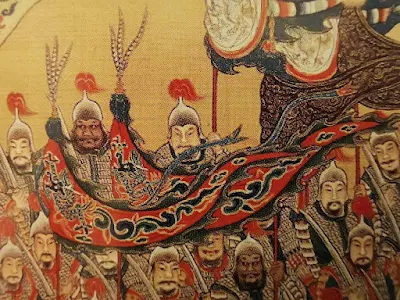The Great Wall of China stands as one of the most iconic and colossal monuments of human endeavor, stretching across China's vast landscape for thousands of miles. But beyond its grandeur lies a complex history shaped by warfare, defense, and ambition. This article explores the true reasons behind the Great Wall's construction and how it evolved over the centuries.
 |
| The Great Wall of China / Image Credit: Pexels |
The Origins: Defense Against Nomadic Invaders
To understand why the Great Wall was built, we must first dive into the threats ancient China faced. Over 2,200 years ago, northern China suffered from constant invasions more than 2200 years ago by nomadic groups like the Xiongnu, who were known for their horseback archery. These warrior nomads, ancestors of the Mongols, frequently raided Chinese settlements, using hit-and-run tactics that made them formidable opponents.
In response, early Chinese states built small, scattered walls from sun-baked mud to protect themselves. These early defenses were not just barriers but strategic strongholds, placed at vulnerable points such as mountain passes and valleys. The walls began as fragmented structures constructed by individual feudal states during the Chunqiu period. However, when Qin Shi Huang unified China in 221 BCE, he began connecting and strengthening these walls into what became known as the Long Wall.
A Complex Linear Fortress
The earliest portions of the Great Wall were constructed using rammed earth—a method in which compacted soil combined with reeds created a strong and resilient barrier in contrast to typical Western fortresses of the same era which concentrated on building with stone and iron. Despite their apparent simplicity, these earthen walls were extremely complex and built to resist both human attack and natural erosion.
The wall’s construction method varied by location. In desert regions, engineers used local materials like reeds and packed earth, while in mountainous areas, stones and bricks were incorporated. As time passed, the wall evolved from a mere barricade to a comprehensive military network, including watchtowers, beacon towers, and troop barracks.
The Qin Dynasty’s Vision
 |
| Qin Shi Huang / Image Credit: Wikimedia |
Emperor Qin Shi Huang, who was known for his brutal and ambitious rule, gave the order to build a single wall to defend his recently united empire. The wall gradually expanded with the help of forced labor, including peasants and prisoners. Workers toiled under harsh conditions, and many perished, leading to legends that the wall itself contains the bones of laborers.
While no human remains have been found within the wall, nearby grave pits suggest many died from hunger, exhaustion, or accidents. Despite its daunting construction, the wall proved invaluable for repelling invasions and signaling threats through beacon fires.
Further Expansion During the Han Dynasty
After the fall of the Qin Dynasty, the Han Dynasty expanded the distance of Great Wall to almost 3,700 miles, stretching from Dunhuang to the Bohai Sea. The Han emperor Wudi recognized the ongoing threat from the Xiongnu and invested heavily in extending and fortifying the wall. Under his rule, the wall became an even more formidable barrier, with additional watchtowers and signal stations.
 |
| Han Wudi of Han Dynasty / Image Credit: Wikimedia |
During this time, the wall’s reputation as a place of suffering deepened, as forced labor remained the primary means of construction. Poets and chroniclers documented the hardship, describing mass graves near the wall’s construction sites.
The Ming Dynasty: A Brick and Stone Revival
The Great Wall underwent significant transformation under the Ming Dynasty (1368–1644). After the Mongols, led by Genghis Khan and later Kublai Khan, breached the earlier walls, the Ming emperors made the decision to fortify the building with bricks and stones. This version of the wall, often associated with the iconic image today, stretched over 5,500 miles and included fortified gates and garrisons.
 |
| Ming dynasty flag / Image Credit: Flickr |
With an average height of 23 feet and a width of 21 feet, the wall’s new design also featured advanced defense mechanisms, including archer openings and larger slots for dropping stones or hot liquids on invaders. Smoke and fire signals efficiently communicated enemy sightings across the vast expanse.
The Wall's Decline and Modern Legacy
Despite the Ming's efforts, the wall ultimately failed to keep out all invaders. In 1644, the Manchu clans from the north conquered the Ming Dynasty and established the Qing Dynasty, rendering the wall obsolete. Without maintenance, parts of the wall fell into disrepair, and locals repurposed its stones for other buildings.
However, the Great Wall’s legacy endured. During World War II, sections were repurposed for defense against Japanese invasions, and in 1987, it was recognized as a UNESCO World Heritage site. Today, the wall is a symbol of resilience and historical continuity, drawing millions of tourists from around the world.
Cultural Significance and Myths
One of the most enduring myths about the Great Wall is its supposed visibility from space. While widely believed, astronauts have confirmed that it’s nearly impossible to see the wall from the moon, and only under perfect conditions might it be discernible from low Earth orbit. Regardless, the wall’s true importance lies not in its visibility but in its representation of human perseverance and ingenuity.
The History of The Great Wall / Video By Ted-Ed
In recent years, preservation initiatives have been initiated to protect the wall from further decay caused by both natural erosion and human activity, including tourism. As new sections continue to be discovered, the Great Wall remains an ever-expanding chapter in China’s historical narrative..
More Than Just a Wall
The Great Wall of China was not just a military fortification but a symbol of the country’s determination to protect its civilization from external threats. Though its military purpose faded over centuries, the wall's historical and cultural significance has only grown, making it an enduring testament to human willpower and architectural brilliance.
